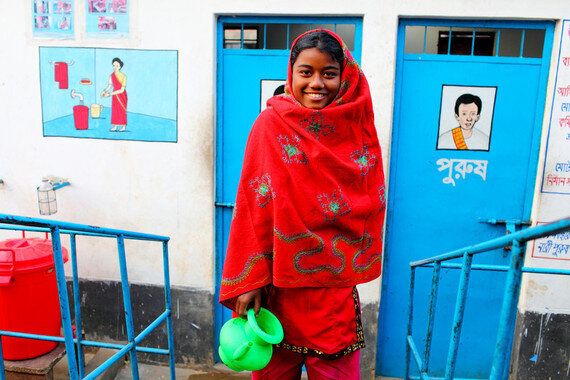The story of two teenage girls raped and murdered in India this spring while looking for a discreet place to relieve themselves outdoors made headlines around the world.
Sadly, their situation is far from unique. Half a billion women and girls - 15% of females worldwide - are forced to do this every day simply because they do not have access to a toilet. This crisis risks women's health, and threatens their safety.
The new Indian government was moved to act following the tragedy of the two Dalit girls in Uttar Pradesh, pledging zero tolerance for acts of violence against women. Their statement is welcome. However, protecting women from harassment and attack will not happen overnight.

Kajal and Sarita walk back from an open defecation area of their village. Nihura Basti, Kanpur, India.
Kajal: "How can you like it when there are lots of men around when you go to the toilet? Sometimes boys take photos on their mobile phones."
Photo credit: WaterAid/ Poulomi Basu
Power imbalance
Violence against girls and women is a result of gross power inequalities in the social structures of many societies. Vulnerable groups, for example lower caste groups such as Dalits in India, are at increased risk, because of this imbalance. Our 2013 survey of almost 10,000 Dalit households from four states in India found that:
- Access to sanitation was just 13%.
- 26% reported women from their household being insulted or humiliated when going to the toilet in the open.
- 6% reported women being sexually harassed.
- 22% reported caste-based discrimination.
The problem isn't confined to India. Our work in Uganda and Nigeria has also shown that women without toilets are at increased risk of harassment and attack.
A 2012 survey WaterAid conducted in the slums of Lagos, Nigeria, showed that a quarter of the women surveyed who defecated in the open had either first or second-hand experience of harassment, a threat of violence or actual assault in the last 12 months. Amnesty International has released similar briefings from Kenya and the Solomon Islands, and we have received anecdotal reports from virtually every country where we work.
The threat of verbal, physical and sexual violence against women in India and elsewhere is not going to be overcome by toilets alone. However, until the day comes when girls and women can move freely in public without fear of harassment or violence, increasing access to a toilet can help make them safer.
India's government has made the ambitious commitment to provide every home with access to water and a basic toilet by 2022. This is not going to be easy to meet. Each year, on average, 16 million people in India gain access to a basic toilet. To reach everyone by 2022, this has to rise to 100 million people a year for the next eight years.
Toilets, and behaviour change
Just building toilets is not enough. Our work over 30 years has shown us that behaviour change is also crucial. In India and across the developing world, cultural practices often do not encourage toilet use. Many people feel that relieving themselves in the open is healthier than using a toilet in a small, enclosed space.
As well as addressing these misconceptions, and encouraging people to install and use toilets at home, service providers need to ensure that public facilities, too, are fit for use. Public toilets need to be available, open, easily accessible and maintained in a decent state, and there need to be good sewage systems to remove waste.

A young girl outside her new latrine block, Kalshi Takar Baa slum, Dhaka, Bangladesh.
For every $1 invested in water and sanitation, an average of at least $4 is returned in increased productivity.
Photo credit: WaterAid/ GMB Akash/ Panos
Providing facilities is one thing. Making sure they meet people's needs is another. Access to safe water and sanitation are basic human rights.
Despite the scale of the challenge, the benefits of increased access to toilets will massively outweigh the investment needed. Over half a million Indians will die this year of diarrhoeal diseases linked to dirty water and poor sanitation. The lack of toilets is estimated to cost India over US$100 million a year.
Massive benefit
Globally, the benefits are even greater. Access to clean water and toilets could save over 1.25 million lives a year and add over US$480 billion to developing economies annually.
While progress has been made on improving access to toilets - in 1990 51.2% lacked access; today the figure is 35.8% - the figures are still unacceptably high and global targets are extremely off track.
Together with Unicef and the World Health Organisation we are calling for the adoption of a Sustainable Development Goal on sanitation, so that everyone, everywhere has access to a toilet by 2030. Our petition to world leaders to recognise water and sanitation as critical issues for girls and women has already received tens of thousands of signatures.
This won't end violence against women alone, but it will stop girls and women fearing harassment, abuse and attack every time nature calls.
